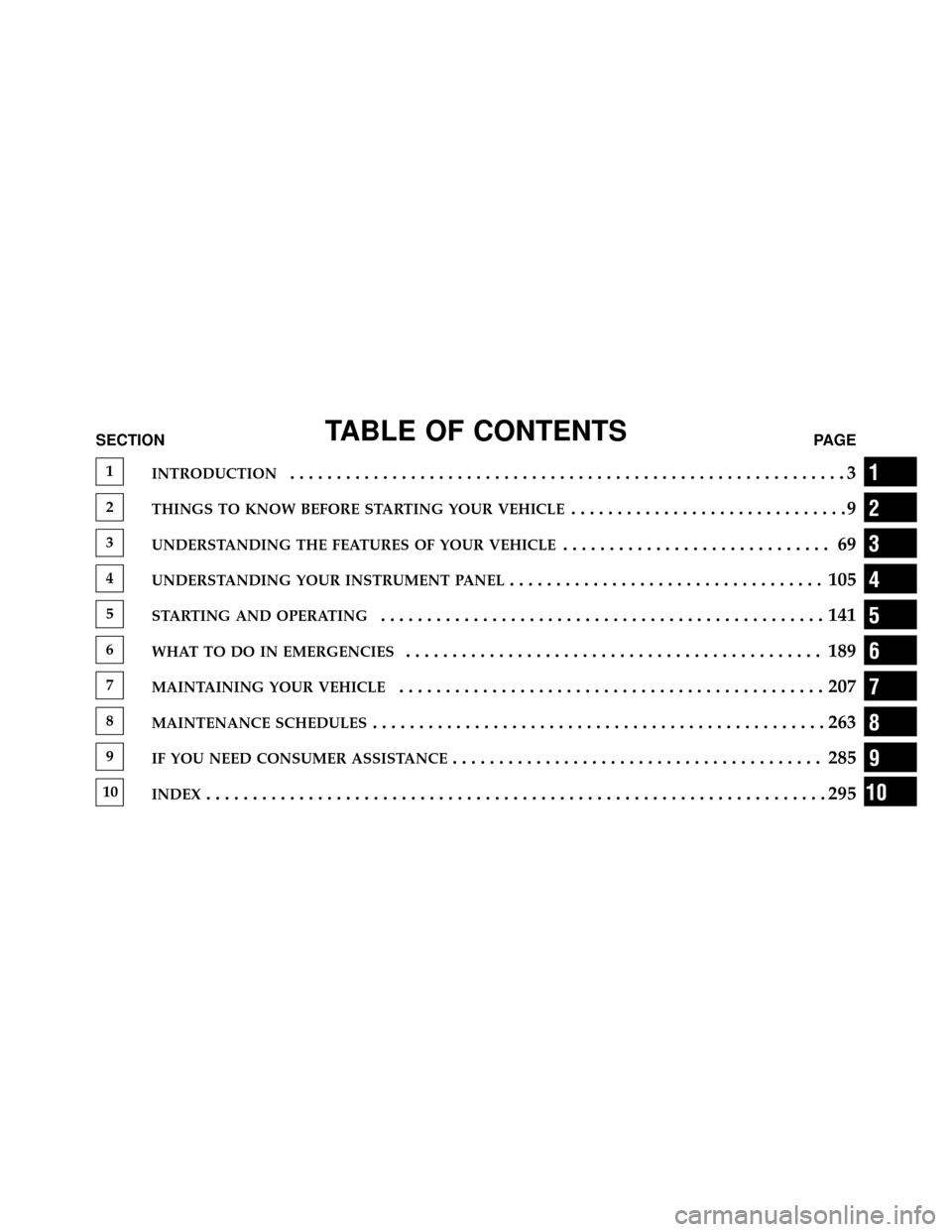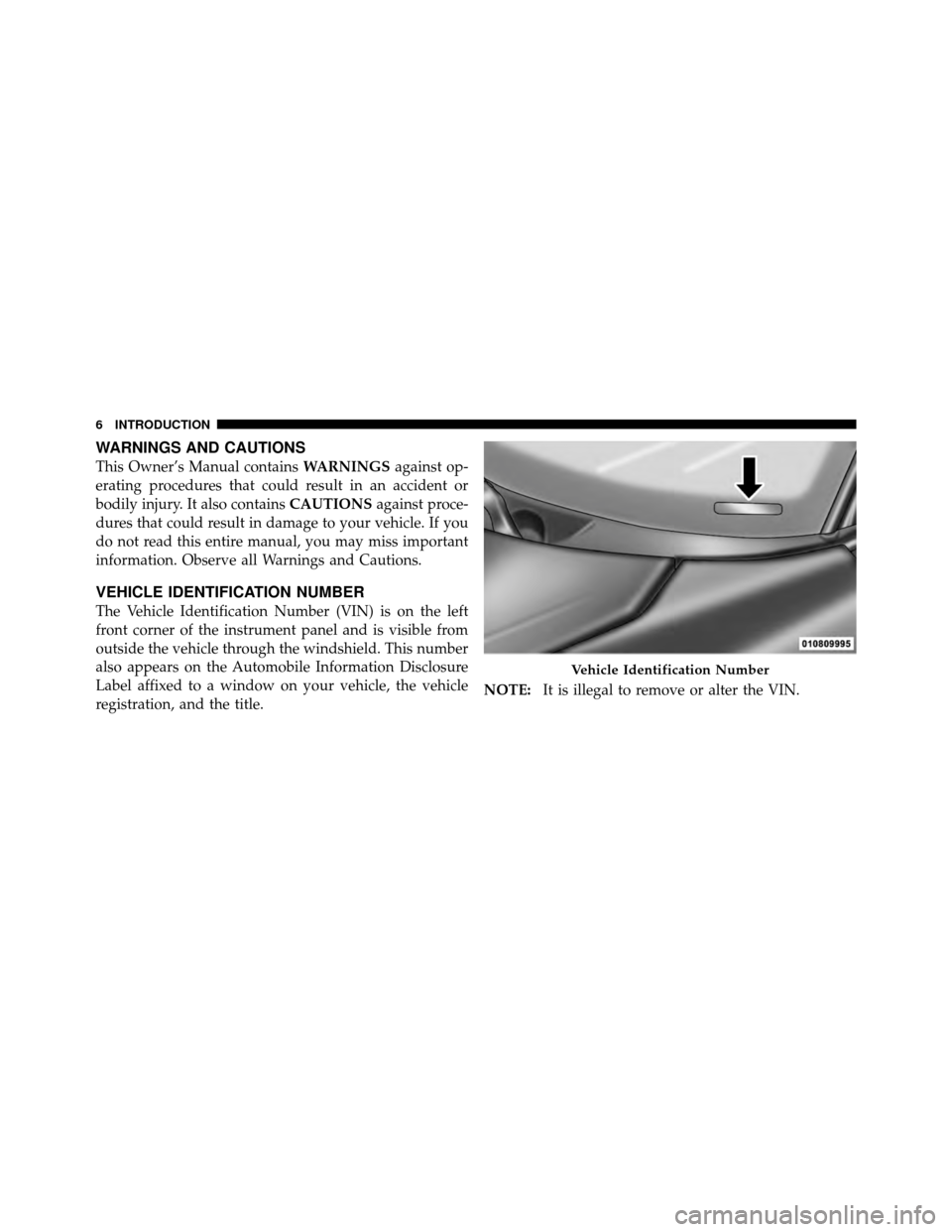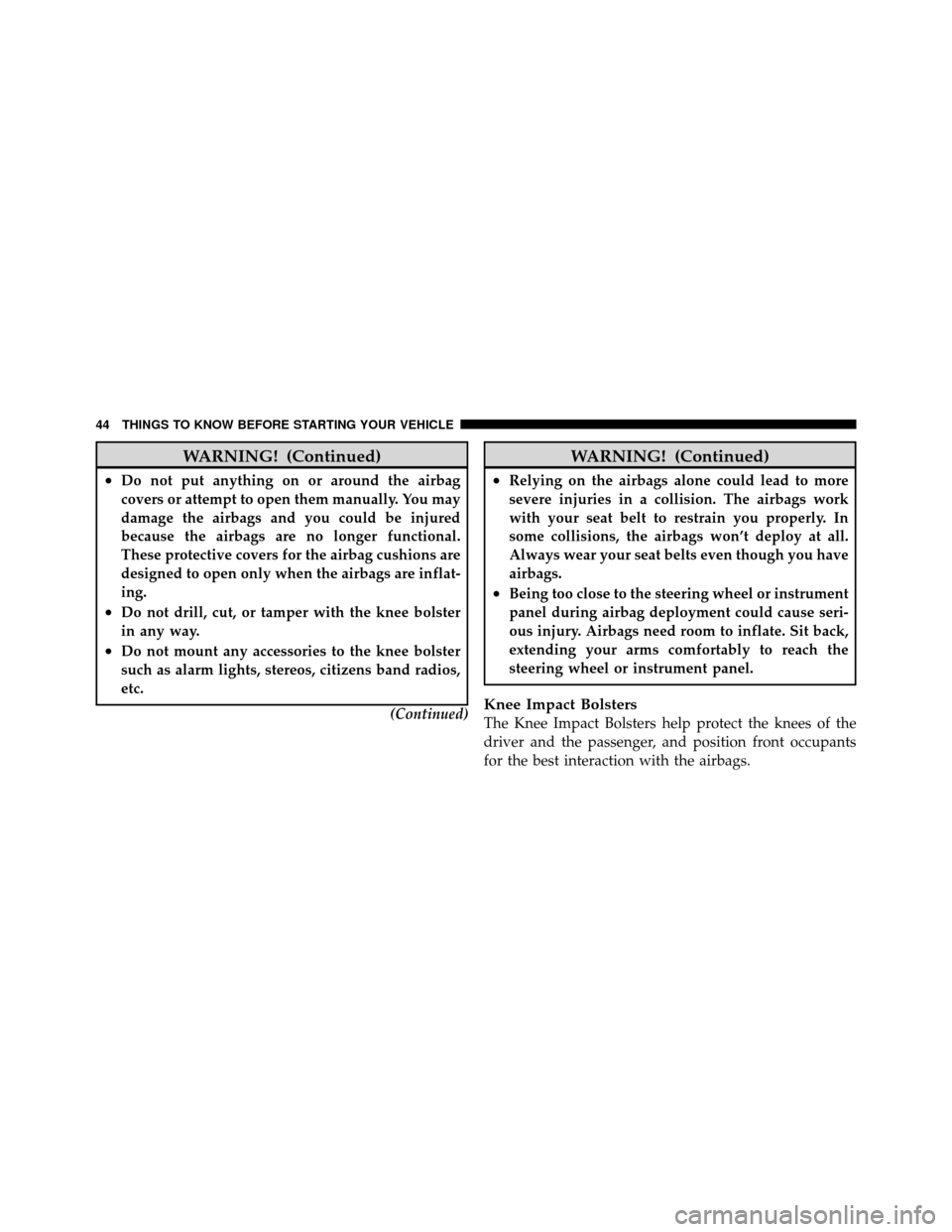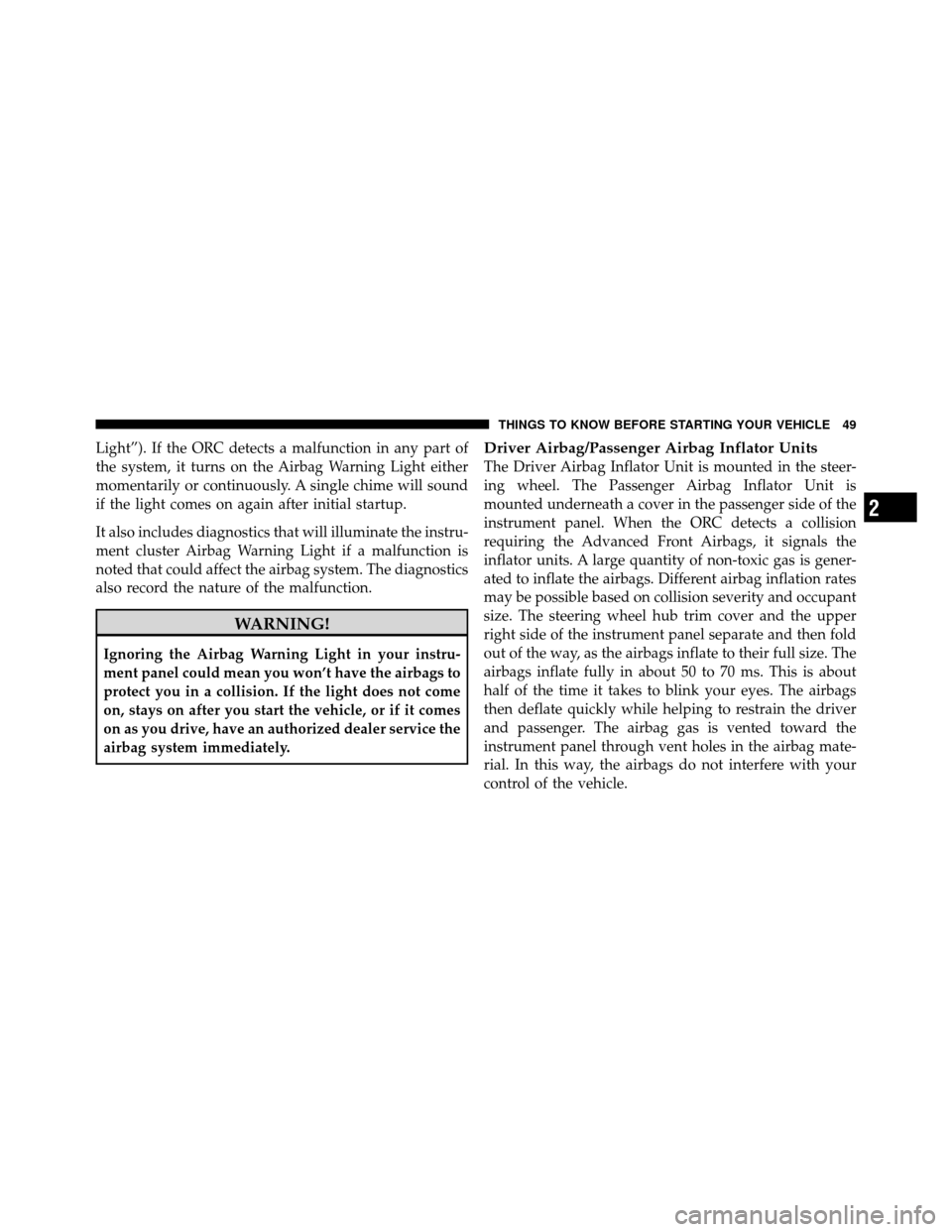2010 DODGE VIPER instrument panel
[x] Cancel search: instrument panelPage 5 of 315

TABLE OF CONTENTSSECTIONPAGE
1INTRODUCTION............................................................3
2THINGS TO KNOW BEFORE STARTING YOUR VEHICLE..............................9
3UNDERSTANDING THE FEATURES OF YOUR VEHICLE............................. 69
4UNDERSTANDING YOUR INSTRUMENT PANEL.................................. 105
5STARTING AND OPERATING................................................141
6WHAT TO DO IN EMERGENCIES............................................. 189
7MAINTAINING YOUR VEHICLE..............................................207
8MAINTENANCE SCHEDULES.................................................263
9IF YOU NEED CONSUMER ASSISTANCE........................................ 285
10INDEX...................................................................295
1
2
3
4
5
6
7
8
9
10
Page 10 of 315

WARNINGS AND CAUTIONS
This Owner’s Manual containsWARNINGSagainst op-
erating procedures that could result in an accident or
bodily injury. It also contains CAUTIONSagainst proce-
dures that could result in damage to your vehicle. If you
do not read this entire manual, you may miss important
information. Observe all Warnings and Cautions.
VEHICLE IDENTIFICATION NUMBER
The Vehicle Identification Number (VIN) is on the left
front corner of the instrument panel and is visible from
outside the vehicle through the windshield. This number
also appears on the Automobile Information Disclosure
Label affixed to a window on your vehicle, the vehicle
registration, and the title. NOTE:
It is illegal to remove or alter the VIN.
Vehicle Identification Number
6 INTRODUCTION
Page 47 of 315

systems. The driver’s Advanced Front Airbag is mounted
in the steering wheel. The passenger’s Advanced Front
Airbag is mounted underneath a cover in the passenger’s
side of the instrument panel. The words SRS/AIRBAG is
embossed on the airbag covers.NOTE:
These airbags are certified to the new Federal
regulations for Advanced Airbags. The passenger’s Ad-
vanced Front Airbag is certified to the Federal regulations
that define Occupant Classification (Refer to “Airbag
Deployment Sensors and Controls”).
The airbags have a multistage inflator design. This allows
the airbag to have different rates of inflation that are
based on collision severity and occupant size.
WARNING!
•No objects should be placed over or near the
airbag on the instrument panel, because any such
objects could cause harm if the vehicle is in a
collision severe enough to cause the airbag to
inflate.
(Continued)
Advanced Front Airbag and Knee Bolster Locations
1 — Driver And Passenger Advanced Front Airbag
2 — Knee Bolster
2
THINGS TO KNOW BEFORE STARTING YOUR VEHICLE 43
Page 48 of 315

WARNING! (Continued)
•Do not put anything on or around the airbag
covers or attempt to open them manually. You may
damage the airbags and you could be injured
because the airbags are no longer functional.
These protective covers for the airbag cushions are
designed to open only when the airbags are inflat-
ing.
•Do not drill, cut, or tamper with the knee bolster
in any way.
•Do not mount any accessories to the knee bolster
such as alarm lights, stereos, citizens band radios,
etc.(Continued)
WARNING! (Continued)
•Relying on the airbags alone could lead to more
severe injuries in a collision. The airbags work
with your seat belt to restrain you properly. In
some collisions, the airbags won’t deploy at all.
Always wear your seat belts even though you have
airbags.
•Being too close to the steering wheel or instrument
panel during airbag deployment could cause seri-
ous injury. Airbags need room to inflate. Sit back,
extending your arms comfortably to reach the
steering wheel or instrument panel.
Knee Impact Bolsters
The Knee Impact Bolsters help protect the knees of the
driver and the passenger, and position front occupants
for the best interaction with the airbags.
44 THINGS TO KNOW BEFORE STARTING YOUR VEHICLE
Page 49 of 315

While the seat belts are designed to protect the driver and
passenger in many types of collisions, the airbags will
deploy in certain frontal collisions depending on the
severity and type of collision. However, even in collisions
where the airbags deploy, all occupants need the seat
belts to keep them in the right position for the airbags to
protect properly.
NOTE:
•The passenger airbag may not deploy if the Occupant
Classification System (refer to “Airbag Deployment
Sensors and Controls”) determines the seat is empty or
is occupied by someone that is classified in the “child”
category. This could be a child, a teenager, or even a
small adult. Therefore, even if the driver’s Advanced
Front Airbag deploys, the passenger’s Advanced Front
Airbag may not deploy.
•Airbag covers may not be obvious in the interior trim;
but they will open during airbag deployment.
•After any accident, the vehicle should be taken to an
authorized dealer immediately.
Airbag System Components
Your vehicle may be equipped with the following airbag
system components:
•Occupant Restraint Controller (ORC)
•Airbag Warning Light
•Steering Wheel and Column
•Instrument Panel
•Knee Impact Bolster
•Driver Advanced Front Airbag
•Passenger Advanced Front Airbag
•Front and Side Impact Sensors
2
THINGS TO KNOW BEFORE STARTING YOUR VEHICLE 45
Page 50 of 315

•Front Seat Belt Pretensioners, Seat Belt Buckle Switch,
and Seat Track Position Sensors
•Occupant Classification System (OCS)
•Occupant Classification Module (OCM)
•Passenger Airbag Disable (PAD) Indicator Light
•Flex Mat
Here are some simple steps you can take to minimize
the risk of harm from a deploying airbag:
1. An infant up to one year or approximately 20 lbs (9 kg)
should never ride in the vehicle because in the event of a
crash, the rear-facing child seat places them too close to
the passenger airbag.
2. An infant in a rear-facing child safety seat, designed
for a child up to one year or approximately 20 lbs (9 kg),
should never ride in the front seat of a vehicle equipped
with a passenger airbag, unless the airbag is shut OFF. An airbag deployment can cause severe injury or death to an
infant in this position. Refer to “Passenger Airbag Dis-
abled (PAD) Indicator Light”.
3. A child who is not big enough to wear the vehicle seat
belt properly should be secured in a child safety seat or
booster seat. (Refer to “Child Restraints”)
4. An older child who does not use a child safety seat or
booster seat should ride buckled properly in their seat.
5. Never allow a child to place the shoulder belt behind
them or under the arm.
6. Never allow a child to lean forward toward the
instrument panel as a passenger airbag deployment
could cause severe injury or death to a child in this
position.
7. For a child from 1 to 12 years old: Move the passenger
seat as far back as possible. For a child from 20 to 60 lbs
(9 kg to 27 kg): Secure them in the appropriate child
46 THINGS TO KNOW BEFORE STARTING YOUR VEHICLE
Page 51 of 315

safety seat or booster seat. If too large for a booster seat,
the child should wear the lap/shoulder belt properly.
8. Read the instructions provided with your child re-
straint to make sure that you are using it properly.
9. Read the instructions provided with your child safety
seat or booster seat to make sure that you are using it
properly.
10. All occupants should always wear their lap and
shoulder belts properly.
11. Position the driver seat and passenger seat as far
away from the instrument panel as practical to allow the
airbags room to inflate. Note that the power adjustable
pedals allow for more driver’s seat adjustment options.
Refer to “Adjustable Pedals” in “Understanding The
Features Of Your Vehicle” for details.Airbag Deployment Sensors and Controls
Occupant Restraint Controller (ORC)
TheORC is part of a Federally regulated safety system
required for this vehicle.
The ORC determines if deployment of the front airbags in
a frontal or side collision is required. Based on the impact
sensors signals, a central electronic ORC deploys the
Advanced Front Airbags, as required, depending on the
severity and type of impact. The airbag inflators are
designed to provide different rates of inflation. Based on
the level of collision severity, the ORC determines the
proper rate of inflation. The ORC may modify the rate of
passenger airbag inflation or prevent passenger airbag
deployment based on input from the Occupant Classifi-
cation System (OCS). The ORC will not detect roll-over or
rear impacts.
2
THINGS TO KNOW BEFORE STARTING YOUR VEHICLE 47
Page 53 of 315

Light”). If the ORC detects a malfunction in any part of
the system, it turns on the Airbag Warning Light either
momentarily or continuously. A single chime will sound
if the light comes on again after initial startup.
It also includes diagnostics that will illuminate the instru-
ment cluster Airbag Warning Light if a malfunction is
noted that could affect the airbag system. The diagnostics
also record the nature of the malfunction.
WARNING!
Ignoring the Airbag Warning Light in your instru-
ment panel could mean you won’t have the airbags to
protect you in a collision. If the light does not come
on, stays on after you start the vehicle, or if it comes
on as you drive, have an authorized dealer service the
airbag system immediately.
Driver Airbag/Passenger Airbag Inflator Units
The Driver Airbag Inflator Unit is mounted in the steer-
ing wheel. The Passenger Airbag Inflator Unit is
mounted underneath a cover in the passenger side of the
instrument panel. When the ORC detects a collision
requiring the Advanced Front Airbags, it signals the
inflator units. A large quantity of non-toxic gas is gener-
ated to inflate the airbags. Different airbag inflation rates
may be possible based on collision severity and occupant
size. The steering wheel hub trim cover and the upper
right side of the instrument panel separate and then fold
out of the way, as the airbags inflate to their full size. The
airbags inflate fully in about 50 to 70 ms. This is about
half of the time it takes to blink your eyes. The airbags
then deflate quickly while helping to restrain the driver
and passenger. The airbag gas is vented toward the
instrument panel through vent holes in the airbag mate-
rial. In this way, the airbags do not interfere with your
control of the vehicle.
2
THINGS TO KNOW BEFORE STARTING YOUR VEHICLE 49